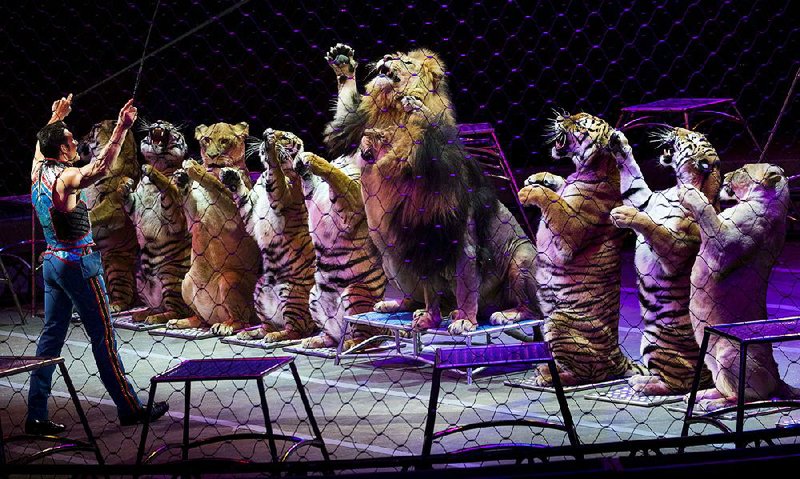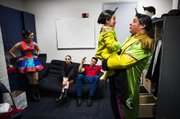It began in 1871 as P.T. Barnum's Grand Traveling Museum, Menagerie, Caravan & Hippodrome, back when Prussia was still a kingdom and Jesse James was robbing banks. It survived the Depression, two world wars and the new media of its time, including radio, film and television.
But on May 21, the world's most historic circus, Ringling Bros. and Barnum & Bailey, will shut down after failing to sufficiently dazzle the children of the smartphone age and to overcome the fierce opposition of the animal-welfare movement, which does not want to see animals in the circus.
Backstage and from the bleachers during a four-day run in Washington, the frenzied spectacle of today is still rooted in its 19th century traditions, with a dash of the modern mixed in. Clowns flop. Trapezists fly. Wild animals jump. Contortionists bend. Horses gallop. Tightrope walkers wobble.
But ticket sales, which had been declining for a decade, plummeted last year, when the elephants left the ring for the last time. Feld Entertainment, which owns Ringling, spent years battling animal-welfare groups and accusations of elephant abuse.
The circus never lost in court; it won a total of $25 million in two settlements from two major animal-welfare groups and beat back allegations that it had mistreated elephants with chains and bullhooks. But a surreptitious 2009 video showing heavy-handed tactics against the elephants and a powerful online campaign helped dampen enthusiasm for the circus, even as Ringling moved to revamp its practices.
"We won in court -- and obviously in the court of public opinion we didn't prevail," said Kenneth Feld, the 69-year-old chairman and chief executive of Feld Entertainment, which bought the circus in 1967 and owns a variety of successful traveling shows, including Monster Jam and Disney on Ice. In an unforgiving marketplace, he said, it just became too hard for the circus to hold on to its most crucial fans: wide-eyed kids and their nostalgic parents.
"There has been more change in the last decade than in the preceding 70 years," Feld said recently. "The circus had to be all things to all people. Now we live in a world of specialization."
Running a circus, even one that has downsized over time, didn't get any cheaper. The operation -- there are two traveling troupes -- is gargantuan: Two mile-long circus trains to move people and equipment; more than 500 performers and crew members to pay and house; 100 animals to care for and feed; 800 costumes; and a universe of props, sound systems and lights.
In a world of distractions, the circus, whittled from five rings to three to, finally, one, found it impossible to compete with cellphones, video games and endless on-demand entertainment. Now, in its last days, the men and women who have dedicated years to an enterprise that felt eternal are looking back with pride, grief and a sense of disbelief that "the greatest show on Earth" is going dark for good.
The Ringmaster
There is no place like the backstage of a circus -- in this case the production of "Out of This World." Unicyclists weave past motorcyclists who rev up to roll into their globe of steel. Clowns in slapstick shoes cross paths with lions waiting in cages for their cues. Acrobats sidestep trapezists who pull up on a practice bar. Poodles in a wagon zip past equestrians who jog in place next to their horses.
Above it all, literally, stands the ringmaster -- Johnathan Lee Iverson, the 6-foot, 5-inch man who became the first black and the youngest person in Ringling history to don the bedazzled top hat and tails. (Last year, a woman stepped in as ringmaster for the first time in the other show.) With his megaphone tenor and towering presence, Iverson opens the circus on a float -- a rocket ship, in this case.
These days, with the circus ambling toward its final farewell, Iverson does less presiding than marveling and philosophizing over this "theater of the impossible" and the talent it boasts. He has spent 18 years and five months as ringmaster with Ringling; the circus is where he got married, welcomed a son and daughter (who are now in the show), saw the world unfurl through the window of a train (his home) and adopted an extended family of international circus performers.
"I wear the moniker of circus freak with pride," said Iverson, 41, who grew up in Manhattan and sang with the Boys Choir of Harlem.
As for his own future, opera may lure him back. A talk show would be wonderful. Playwriting is a possibility.
But Iverson also carries traces of disappointment. The way he sees it, Feld Entertainment should have used a little more razzmatazz in its publicity and marketing -- concepts that P.T. Barnum practically invented -- particularly on the "World Wide Web," as he calls it, to save the circus and counter the narrative of the animal-welfare groups.
"We are selling miracles," Iverson said. "I don't care how old you get, how much technology advances, people will always be enamored with other people flying and doing daring things."
The Animal Trainer
The first thing Alexander Lacey, Ringling's heartthrob animal trainer, does every morning after he feeds and waters the 14 lions, tigers and one leopard he has raised since birth is gauge their mood. Who is grouchy? Is a female in heat? Does Max the tiger's growl mean he's hungry or tired? Is Goldie the lion's penchant for laziness just that, or something more?
"You have to really learn to read them," said Lacey, 41, who was born in England into a lion and tiger-training family. "Once you understand your animals so well, there is no reason to be scared of them, because you are never going to put yourself in a position where it is dangerous."
The worst injuries he has suffered are scars and scratches. In and out of the ring, he hugs many of his lions and tigers and, with Masai, a male lion, he kisses him on the mouth and lets the lion lie on top of him. In his last act, he stuck his head in Masai's mouth.
"His breath doesn't smell, but if he burped, I was green by the time I came out," said Lacey, whose quips backstage are as common as clown gags onstage.
Like so many other Ringling performers, his family springs from the circus. His mother and father ran a zoo in Chester, England (where they met), until he was 6. Then they ran a circus and started breeding big cats.
At 12, Lacey announced that he wanted to be a lion trainer. "Everyone does," his father replied. He suggested that Lacey prove his dedication by caring for the animals and picking up their poop for five years. Lacey obliged. At 21, he finally took the stage with his own lions and tigers.
Wild animals at Ringling have long sparked protest. In 1925, the Ringling Bros. dropped the acts because "the impression has been spread that wild animals are taught their tricks by cruel methods," they told The New York Times. They changed their minds when legendary lion tamer Clyde Beatty was hired in 1931.
Today's animal-welfare groups raise the same issues. They say animals simply don't belong in captivity.
Beatty's whip, pistol and chair are long gone. Gunther Gebel-Williams, the trainer and performer, changed the culture of animal training. It's one that Lacey embraces. Starting at 8 months, the lions and tigers learn through a system of meat treats, guides (a thin pole) and repetition. Lacey puts his nose in their mouth and blows when they are tiny to get them used to the feel. As they grow, his face goes deeper into their mouths. Two years later, they perform, doing jumps, lying down, rolling over.
When the animals play, he notes which tiger stays up the longest on its hind legs and assigns it that trick. The less social ones he teaches to fake-attack onstage. They know to snarl and wave their paws to draw oohs and applause.
"Audiences want to be excited a little bit," he said. "Everybody wants to see the trapeze guy fall off and the lion trainer killed."
The Cossack Riders
The act never fails to draw gasps and cheers. Tatiana Tchalabaeva hangs upside down off her horse, Bunny, one strap across her foot, her head inches from the ground. Two men ride horses side by side at a gallop as a woman straddles them, one foot on each man's shoulders. It seems a fall could come at any moment.
Equestrianism was a building block of Ringling, along with clowns and acrobats. For Tchalabaeva and the other 15 equestrians, who come mostly from Kazakhstan, Uzbekistan and Mexico, the job is about pushing boundaries. And that requires constant work. (The person in charge is her husband, Kanat, the trainer.)
"We try to keep our act at a very, very high level," said Tchalabaeva, 43, with her Russian lilt, as she waited to put on her flowing green costume for the role of the evil Queen Tatiana. "We are creating something new every day."
Broken bones, stitches and bruises are part of the job, even though the equestrians learn to roll away from horses to avoid being crushed. Horses can trip, sending riders flying. Riders can mistime the speed of a horse and fall.
It is dangerous and exhausting work. Staying fit is crucial. (Tchalabaeva does sit-ups and push-ups.) "Horses require a lot of your strength," she said. "To do it, flawlessly and nice and easy looking, you have to be in great shape."
And as with Lacey and his big cats, caring for the horses is a full-time job. The equestrians exercise them, visit them in the barns, feed them treats and rub their noses. The result can be seen backstage. Fourteen horses, lined up two by two, look serene before racing into the ring.
Tchalabaeva, who started as a rhythmic gymnast, has spent 13 years at Ringling, on and off, and her two daughters, 7 and 14, have grown up there. When news spread that the circus was closing, she was in shock. Her children, who go to school at the circus with teachers and use an online program, wept. This is home.
"You know, it's the best show in the world; it's everybody's goal and dream," she said. "It's like underneath, the floor, being taken out of you."
She can't help but feel bitter about the loss of the elephants and the virulence of the animal-welfare groups, she said. She recounted spending $10,000 on surgery to save a horse that was badly injured by another stallion. It was misrepresented by animal-welfare groups as a tale of abuse, she said.
"To me, I wish more people would believe us and protect us and support us," she said, her voice cracking. "If I can be a spokesman for that, believe me, I will go anywhere I need to go."
The Clown
Davis Vassallo paints red cheeks on his daughter, then moves over to her lips, getting her ready to play a child version of his character. Adriana is 7. It is a family business, clowning, and she is its fifth generation.
"My father and grandfather were clowns in a little circus in Italy," said Vassallo, 37, the head clown. "My father was an acrobat and a clown because a clown needs to do a little bit of everything."
If elephants were Ringling's most famous icons, clowns embody its soul.
"We go out there and make people forget about their problems," said Vassallo, who has been with Ringling four years. "And then we forget our own problems. We live for that."
Right before a show, Vassallo, who spent his childhood in Italy shuffling from town to town, changing schools every time, empties his mind. He thinks about nothing, and then gauges the audience. "You can't plan clown gags," he said.
Clowns have always been multitaskers, a survival technique. Vassallo is an acrobat and a tightrope walker, which his father taught him. In the show, he walks the tightrope, performing several sitting somersaults, and does a handstand atop a 47-foot sway pole.
In modern-day arenas, clowning has also grown bigger -- larger gestures, more falls, gargantuan props.
Vassallo is a "sweet clown" because he was told he has a sweet face. Even for a clown, it's hard to cut against type. And he wears little makeup. ("I've been told I look stupid in makeup," he said, laughing.) Mimicry is his signature. He uses his expressive face and, in this show, his squeaky voice to embody a character.
Soon, he will move on, as he always has, to another circus, or perhaps theater. With sawdust in his lineage, walking away is impossible. "Every time I go home, I get bored," he said. "That's when you realize you love your job."
SundayMonday on 04/09/2017



